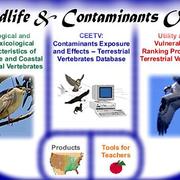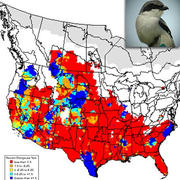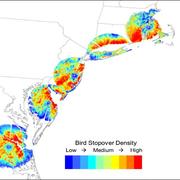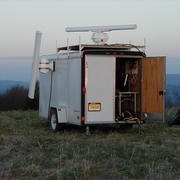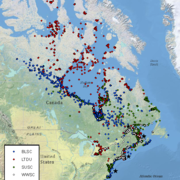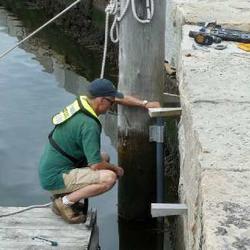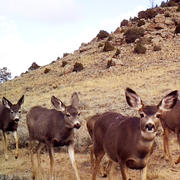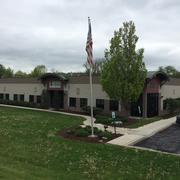Due to a lapse in appropriations, the majority of USGS websites may not be up to date and may not reflect current conditions. Websites displaying real-time data, such as Earthquake and Water and information needed for public health and safety will be updated with limited support. Additionally, USGS will not be able to respond to inquiries until appropriations are enacted. For more information, please see www.doi.gov/shutdown
Regions
Northeast
Regions L2 Landing Page Tabs
One of the major strengths of the Northeast Area is the enthusiasm and commitment of our scientists to produce the type of high quality science that the USGS is known for. Working together with our partners across the nation, we have the ability to provide complete, integrated and holistic environmental information that will produce the best results that we can achieve.
Contaminant-related Activities in Support of Client Agencies in the Department of the Interior
The Challenge: The Department of the Interior has extensive responsibilities for management of fish and wildlife, and their supporting habitat. Stewardship activities include assessment of potentially adverse effects of natural and anthropogenic stressors on biota, including chemical contaminants. We assist by providing scientific information to support development of federal guidelines, ...
Toxicity of Polybrominated Diphenyl Ethers and Other Flame Retardants to Wildlife
The Challenge: Polybrominated diphenyl ether flame retardants (PBDEs) are contaminants that bioaccumulate and biomagnify in aquatic and terrestrial food webs. Unlike many contemporary pollutants, these flame retardants have increased in the environment over the past 30 years. Studies in Chesapeake and Delaware Bays have documented concentrations of nearly 1 μg/g wet weight of PBDEs in osprey...
Contaminant Exposure and Effects—Terrestrial Vertebrates (CEE-TV) Database Summary Findings for Trust Resources in U.S. Coastal Habitats
The Challenge: The National Contaminant Biomonitoring Program of the U.S. Fish and Wildlife Service has been the only large-scale effort that has examined contaminant exposure in terrestrial vertebrates in the United States. Halogenated contaminants, metals, and new pollutants continue to pose hazards to wildlife at many geographic scales. To address this hazard, critical data gaps are being...
Comprehensive 1966 - 2015 Results! North American Breeding Bird Survey
The Challenge: Like the canary in the coal mine, wild birds have long been recognized as bellwethers for environmental health. By monitoring populations of wild birds we gain an understanding of the state of the natural world and this, in turn, allows us to identify pressing environmental challenges, to set conservation priorities, and to measure the success of conservation action. But the...
Development of Robust Bird-based Climate Change Indicator
The Challenge: Appropriate ecological indicators of climate change can be used to measure concurrent changes in ecological systems, inform management decisions, and project the consequences of climate change. Breeding bird distributions are predicted to be sensitive to changes in climate, and could be useful climate-change indicators. We seek to develop robust bird-based, climate-change...
Response of Migrating Birds to Hurricane Sandy
The Challaenge: Each autumn, millions of landbirds migrate southward from breeding areas in the U.S. and Canada. Because these migrations occur during hurricane season, the impacts of hurricanes on migrating birds and their en route resting and foraging sites (stopover sites) are a real concern. Hurricane Sandy occurred late in the landbird migration season. By the time the storm made landfall...
Nocturnal Bird Migration through the Central Appalachians
The Challenge: Concerns have arisen about the potential impacts of wind power development in the Appalachians on migrating birds, creating a critical need for information on their distribution and flight characteristics as they pass through the region. This study focuses on the spatial and temporal distribution of nocturnally migrating birds in the Central Appalachians (MD, VA, WV). The...
Radar Analysis of Fall Migration Stopover Sites in the Northeastern U.S.
The Challenge: Most landbird conservation efforts focus on protecting or enhancing breeding habitat. For migratory species, however, mortality is highest during the biannual migration periods. In fall, juvenile birds are making their first migratory flights; their success, and that of adult birds, depends on availability of suitable sites to safely rest and forage. Identifying important...
Poisoning of Migratory Birds at Contaminated Sites
The Challenge: The Department of the Interior (DOI) and the National Oceanic & Atmospheric Administration are trustees for a wide variety natural resources that belong to all Americans. Additional natural resources are overseen by Native American tribes, states, and other federal agencies. Migratory birds are an example of a trust species for DOI, under the US Fish and Wildlife Service....
Migration and Habitat Use by Seabirds in the Atlantic Flyway: Evaluation of Potential Impacts of Proposed Wind Farms
The Challenge: Demands for alternative energy are increasing and offshore wind projects are slated for several areas used by seabirds in coastal areas of the Atlantic flyway and in the Great Lakes. There is a need to identify the most important habitats for seabirds related to the construction of turbines to evaluate and minimize potential adverse effects on seabirds and their habitats. This...
Effects of Dorsally Mounted Solar-powered Cellular GPS Transmitters on Diving and Foraging in Surf Scoters and Red-throated Loons
The Challenge: Numerous proposals for construction of offshore wind farms have scientists racing to determine seabird migration routes and habitat use throughout coastal waters. Two common species of primary concern are redthroated loons (Gavia stellata) and surf scoters (Melanitta perspicillata). While much valuable data has been collected on these species through the use of implantable...
In-Air and Underwater Hearing Abilities of Seabirds
The Challenge: Underwater noise pollution from anthropogenic activities such as offshore energy construction, naval sonar activity, and commercial shipping can impact aquatic animals. Introduction of anthropogenic noise sources can mask communication, displace animals from preferred foraging or breeding habitat, disrupt predator-prey interactions, and cause hearing loss. Many seabirds spend a...
Water-quality sampling on Long Island
USGS hydrologists Irene Fisher and Michael Como sample water quality on Long Island.
Joseph Levitt secures the new buoy off Weirs Beach, NH
USGS scientist Joseph Levitt secured the new buoy, equipped to monitor water quality, at Weirs Beach on Lake Winnepesaukee, New Hampshire in June 2016. Photo: Sanborn Ward, USGS
A new buoy for Lake Winnipesaukee
In June, USGS scientists deployed a new high tech buoy that will help determine when the water is safe for swimming at popular Weirs Beach on New Hampshire's Lake Winnepesaukee. Photo: Richard Kiah, USGS.
Hurricane erodes N.C. road
As US models predicted Hurricane Joaquin washed out a road at Kitty Hawk, NC in 2015.
A long-tailed duck, 2 days old
A long-tailed duck, two days old, standing.
Field Activity 2016-005-FA North of Nantucket, MA
Woods Hole Coastal and Marine Science Center scientists aboard the RV Rafael prepare to launch the Mini SEABOSS just off of Nantucket! The Mini SEABOSS collects samples, photos and video of the seafloor.
New England Water Science Center sealed cap installation
New England WSC - Acoustic Doppler at Salmon Creek
New England WSC - Acoustic Doppler at Salmon Creek
Woods Hole Coastal and Marine Science Center
Image of the Woods Hole Coastal and Marine Science Center, Woods Hole, Massachusetts
DDT nearly wiped out these birds, now they’re making a comeback
Washington Post article on the impacts of DDT on birds.
Discharge Measurement at Moyer Creek
USGS Hydrologist Travis Smith makes a wading (section-by-section) discharge measurement at Moyer Creek stream gauging station near Frankfort, NY to allow for better estimates of streamflow during ice-affected periods in winter.




